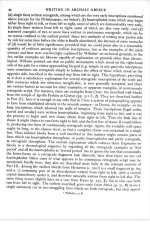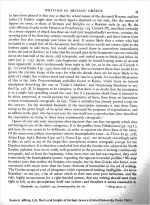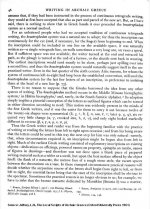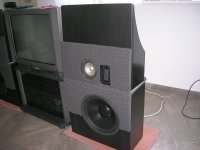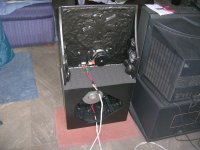Its not common-mode
Oops. 🙄
Mouser has this "common mode filters/chokes" category which is very confusing, either for me or for their database staff. I'm not sure which.
That's plausible, as the distributed C would be 281pF.
Ironically that's how I got to my 3kHz figure - picked a plausible amount for the parasitic C and plugged it into the equation 😉
https://en.wikipedia.org/wiki/Gortyn_code )
Thank you for giving me the opportunity to think over it.
George
You're welcome. You would think Greeks of all folks would have carved such in a big spiral around a circular wall.
I remain scratching my head over recent conversations. I admit I have little or no interest in speaker crossover/room equalization but your plots show output before the input that caused it or am I missing something?
Yes someone needs to brush up on her/his nomenclature at Mouser. They are pretty good overall, but I've gotten bags of stuff that were wildly wrong.Oops. 🙄
Mouser has this "common mode filters/chokes" category which is very confusing, either for me or for their database staff. I'm not sure which.
I also tried to find another choke for which Mouser published a resonant frequency, but to no avail. Somewhere I have some of the Hammonds with a lower inductance, but I think of comparable dimensions. If I run across them I will do a measurement.
I was just looking at this headphone amplifier from TI - very popular on all the headphone sites.
http://www.ti.com/lit/ds/symlink/tpa6120a2.pdf
The data sheet is so badly written. The intro on the first page is pure marketing drivel and there are glaring technical errors in the description of why the device is supposed to be superior as a headphone amplifier.
Shame on you TI!
(we should start a data sheet bs tracker on the site to call out vendors that mix technical specifications up with marketing b.s. )
http://www.ti.com/lit/ds/symlink/tpa6120a2.pdf
The data sheet is so badly written. The intro on the first page is pure marketing drivel and there are glaring technical errors in the description of why the device is supposed to be superior as a headphone amplifier.
Shame on you TI!
(we should start a data sheet bs tracker on the site to call out vendors that mix technical specifications up with marketing b.s. )
" . . . which is very confusing, either for me or for their database staff. I'm not sure which."
LOL - very well said!
LOL - very well said!
Perhaps the original March 2004 datasheet was written by and for audio engineers but someone in management thought it needed sexing up. Could we have a thread called 'Dodgy Dossier' for this type of thing, or would the title be considered too political in the light of certain UK events?
it is a rebadged THS6012 DSL driver chip so you can read that datasheet too for more "conventional" specs - certainly beats the AD811 that is still revered in composite multiloop headphone amps and audio line driver circuits
driving 25 Ohms with low distortion to reduce inter-symbol interference in high rate QAM from 100kHz to few MHz doesn't seem completely bad for headphones or line drivers in audio
the effort to make audio relevant measurement seems useful - hard to satisfy everybody given the general lack of agreement on what specs are relevant for audio however
but THD vs frequency, level and load plots are a lot more info than thd @1 kHz just below clipping
they have revised the datasheet showing somewhat worse numbers than originally
I did like the IMD plot in the older datasheet I think it shows the (very small) thermal feedback distortion rise at mid audio frequency that is seldom looked for
but still fine standalone and my preferred use as an output amp in a multiloop easily reduces active device distortion contribution below layout and many passive component's contributions
driving 25 Ohms with low distortion to reduce inter-symbol interference in high rate QAM from 100kHz to few MHz doesn't seem completely bad for headphones or line drivers in audio
the effort to make audio relevant measurement seems useful - hard to satisfy everybody given the general lack of agreement on what specs are relevant for audio however
but THD vs frequency, level and load plots are a lot more info than thd @1 kHz just below clipping
they have revised the datasheet showing somewhat worse numbers than originally
I did like the IMD plot in the older datasheet I think it shows the (very small) thermal feedback distortion rise at mid audio frequency that is seldom looked for
but still fine standalone and my preferred use as an output amp in a multiloop easily reduces active device distortion contribution below layout and many passive component's contributions
Last edited:
You're welcome. You would think Greeks of all folks would have carved such in a big spiral around a circular wall.
Scott
I wait an answer from someone who is to be considered a scholar.
I did some reading today, I copied four pages from a very good book, there is a different explanation from the one I wrote before.
but your plots show output before the input that caused it or am I missing something?
I try but I have not achieved time reversal yet. 😀
On test were a U frame 15”woofer and an OB 4”wide bander with an active two-way crossover 140Hz LP LR48dB/oct and 140Hz HP LR48dB/oct
Two measurements for each way: Acoustic response captured through mic 1m away, in line with the resp driver (the jarred lines), and electric response captured through output of cross over (the smooth lines).
What those plot showed was the effect that impulse response windowing has on gain and phase diagrams (yes, it is confusing)
George
Attachments
I was just looking at this headphone amplifier from TI - very popular on all the headphone sites.
http://www.ti.com/lit/ds/symlink/tpa6120a2.pdf
The data sheet is so badly written. The intro on the first page is pure marketing drivel and there are glaring technical errors in the description of why the device is supposed to be superior as a headphone amplifier.
Shame on you TI!
(we should start a data sheet bs tracker on the site to call out vendors that mix technical specifications up with marketing b.s. )
I read it as being written by someone not quite fluent in English or even American usage.
I always had the kids pair up (re relative size) and do a "here we go round the mulberry bush." The lighter kid did more of 'an orbit' and the bigger kid wobbled, so it was good ...
Pluto/Charron is awesome! 😉 [Not just Pluto but Pluto/Charron!]
The View from New Horizons: A Full Day on Pluto-Charon | NASA
And don't even get me started about getting kicked out of The Club!!1!1|!! 😡
PS I work at a private school named New Horizons ...
Ohhhh Yeaaaahhhhhh h h!
Last edited:
Would one of you happen to know the ballpark value for the self-resonance of this Hammond 10H common mode choke?
157H Hammond Manufacturing | Mouser
From Hammond data sheet.
Nothing about resonance.
Attachments
There is one other choke from Hammond in the listings on the Mouser site which has an entry in the self resonant frequency column, and which reinforces the notion that the data entry person just pulled the number out of the air. It's for a 320mH part, and yet the SRF is still 60Hz. Ludicrous.From Hammond data sheet.
Nothing about resonance.
So the 10H number is almost certainly bogus as well.
I mean the 60Hz SRF is likely bogus---I have no reason to doubt the 10H. But for a 320mH and a 10H to have the same very low SRF is unlikely, so I think Mouser just made a couple of errors.It appears to be a 10H choke to me. Just measure it.
I read it as being written by someone not quite fluent in English or even American usage.
No excuse.
And no excuse for the technical claims tat are just plain wrong.
Andrew's complaint notwithstanding. this is the future of audio. It will all boil down to integrated electronics, to save on space and cost, and end up as an add-on PC card. Only the remaining few will still use classic design techniques, using discrete or hybrid dicrete and integrated electronics.
- Status
- Not open for further replies.
- Home
- Member Areas
- The Lounge
- John Curl's Blowtorch preamplifier part II
 )
)
